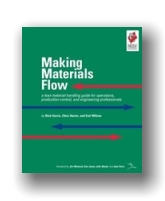About This Book

A Shingo Research Prize recipient for 2005!
Making Materials Flow describes in plain language another step in implementing a complete lean business system.
LEI’s first workbook, Learning to See, focused on where to start – at the value stream for each product family within your facilities.
Seeing the Whole then expanded the value-stream map beyond facility walls, all the way from raw materials to customer.
After mapping has identified waste and potential applications of flow and pull, you can use the techniques in Creating Continuous Flow to implement truly continuous flow in cellularized operations.
Making Materials Flow takes the next step by explaining how to supply purchased parts to the value stream in order to support continuous flow.
“Companies are making progress in creating areas of continuous flow as more managers learn about value-stream mapping and continuous-flow cells,” said co-author Rick Harris, who also co-authored the Creating Continuous Flow workbook. Both workbooks have received Shingo Research Prizes.
During visits to plants Harris has noticed an unsettling trend. “As I walk through facilities and examine earnest efforts to create continuous flow, I see how hard it is to sustain steady output. The problem often is the lack of a lean material-handling system for purchased parts to support continuous flow cells, small-batch processing, and traditional assembly lines.”
Making Materials Flow explains in plain language how to create such a system by applying the relevant concepts and methods in a step-by-step progression. The workbook reveals the exercises, formulas, standards, and forms that a consultant would use to implement the system in your environment. And, like LEI’s other workbooks, Making Materials Flow answers the key question managers often have about lean manufacturing tools and concepts, “What do I do on Monday morning to implement this?”